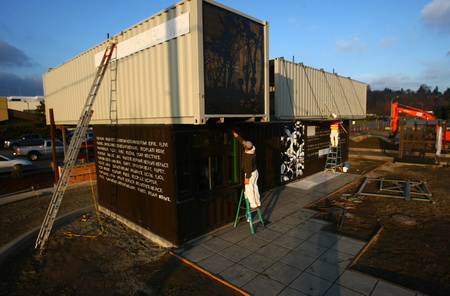Rumor has it that Starbucks cafes of the future might be rectangular and metal just like shipping containers. Starbucks, which is about to launch juice business soon, also cares about environment and intends to re-use real shipping containers as new drive-thrus.

Photo: A shipping containers turns into a Starbucks cafe on East Marginal Way, by Joshua Trujillo
Earlier this week, a construction crew on East Marginal Way in Tukwila was assembling several cargo-style containers stacked on top of each other. The containers are painted shades of brown and feature a drive-thru window on one side, says Seattle Pi.
How do we know the containers belong to the coffee company? There are words ‘Regenerate, Reuse, Recycle, Renew, Reclaim’ written in a font familiar to Starbucks the side of one container. According to the construction crew they were building an eco-friendly drive-thru for Starbucks.
Shipping containers is the latest trend in the green building movement—there is a lot of them at American ports and are in need of recycling made a splash on the sustainable design scene lately.
Starbucks have not commented on the containers topic yet but the city of Tukwila issued a building permit to the Seattle company with the intended development purpose: “A new drive thru/walk-up building for Starbucks Coffee Company.”
In addition, the company seeks for a shift supervisor on its site, obviously to work at the new drive-thru. On the backdrop of Starbucks’ aim to go greener and make greener buildings, the idea of recycling shipping containers sounds good. It’s not clear if other shipping-container Starbucks have debuted quietly in other locations, or if the company plans to replicate the design.
The Starbucks spokesperson Alan Hilowitz said in an interview to New York Times that this store would be rare among the 17,000 Starbucks stores globally in that it will be drive-up and walk-up only with no space to lounge inside.
And it will be portable, he said, easy to break it down and transport somewhere else. “We see a lot of opportunities here,” he said. “We can put a store like this on a lot that will be developed someday but is free for two or three years, and then we can move it.”
